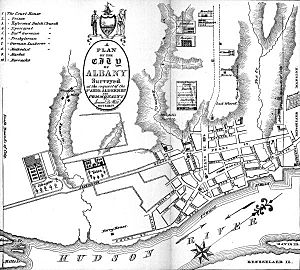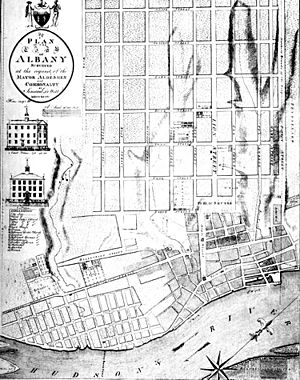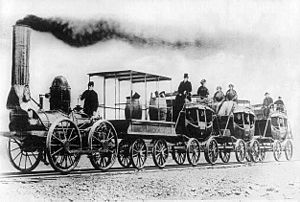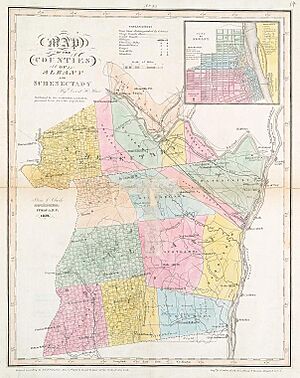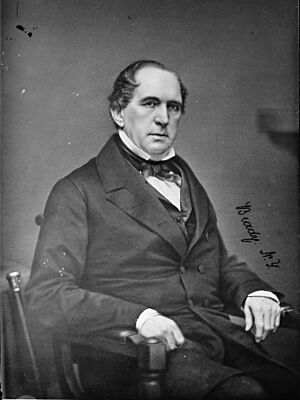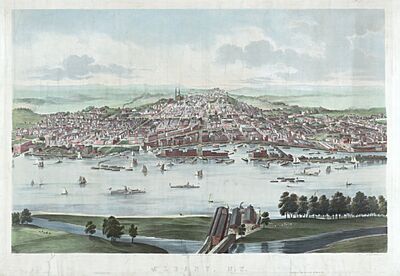History of Albany, New York (1784–1860) facts for kids
This is the story of Albany, New York, from 1784 to 1860. This period started right after the American Revolutionary War and ended just before the American Civil War.
After the Revolutionary War, many people bought and sold land in Albany County. The upper Hudson Valley became peaceful after a big battle at Saratoga in 1777. Soon, the whole Upstate New York area began to do well. People from Vermont and Connecticut moved in. They liked living near the Hudson River and trading in Albany. It was also only a few days' boat trip to New York City. In 1790, Albany had 3,498 people. This was a huge increase since it became a city. In 1797, Albany became the permanent state capital of New York. Before this, the state government often moved between Albany, Kingston, Poughkeepsie, and New York City. Albany is the second oldest state capital in the United States.
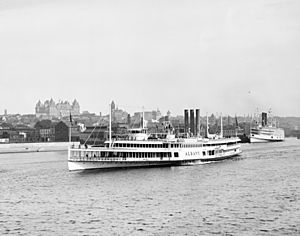
Albany has always been a major center for travel and trade. In the late 1700s and early 1800s, turnpikes (toll roads) were built. By 1815, Albany was the main turnpike center in New York. A new street plan by Simeon De Witt in 1794 gave Albany its unique street names, like those of birds and mammals. These new roads helped make Albany a travel hub. Pioneers heading to Buffalo and the Michigan Territory often passed through Albany.
In 1807, Robert Fulton started the first successful steamboat line from New York City to Albany. By 1810, Albany had 10,763 people. It was the 10th largest city in the nation. In 1815, the town of "the Colonie" to the north was added to Albany. In 1825, the Erie Canal was finished. This canal created a water route from the Great Lakes all the way to New York City. The original Erie Canal ended in Albany. Lock 1 was just north of Colonie Street. The canal emptied into a large, man-made lagoon called the Albany Basin. This was Albany's main port until 1932.
In 1829, Joseph Henry, a professor at the Albany Academy, built the first electric motor. He is known as "the top American scientist of the 19th century." Later, he discovered electromagnetic self-induction. The unit for this is now called the henry. He also became the first leader of the Smithsonian Institution. In the 1830s and 1840s, Albany was still one of the top 10 largest cities in the nation.
Albany also has a rich history with trains. Two major railroad companies had their main offices here. The Delaware and Hudson Railway was based in Albany. In 1853, Erastus Corning, a famous businessman and former mayor of Albany, combined ten railroads. These railroads stretched from Albany to Buffalo. He formed the New York Central Railroad (NYCRR). Its headquarters were in Albany until 1867. One of these ten companies was the Mohawk and Hudson Railroad. This was the first railroad in New York State. It was also the first successful steam railroad in the country with regular service.
Albany's Growth After the Revolution (1784–1800)
After the American Revolution, Albany grew in many ways. It grew physically, in business, and in culture. The first post office in Albany opened in 1784. In 1785, the city decided to change street names that sounded too "English." Fort Frederick was torn down, allowing the city to expand west. Also in 1785, a ship called the Experiment sailed from Albany to China. It was only the second American ship to go to China.
In 1786, comedians performed regularly in Albany for the first time. John Lansing Jr. became mayor that year. In 1788 and 1789, stage lines (like early bus lines) connected Albany to nearby towns. Before this, stagecoach service only went to New York City. This was the start of Albany becoming a major transportation center. More stage lines opened in the early 1790s, reaching places like Vermont and Oneida County. By 1811, stage lines even reached Buffalo and Niagara Falls. Soon, turnpikes began to spread out from Albany.
The first national census in 1790 showed Albany had 3,498 people. Albany County had 75,180 people, making it very large. Also in 1790, street names were officially changed. East-west streets were named after mammals, and north-south streets after birds. Many bird-named streets still have those names today. Abraham Yates Jr. became mayor that year. The government also approved a main road from Albany to Canajoharie. The Albany Library and the Bank of Albany were started in 1791. In 1797, the Albany Museum was created.
More people from New England moved west as roads improved. By 1795, hundreds of sleighs passed through Albany daily in February. After Mayor Yates died, Abraham Ten Broeck became mayor again.
In 1797, Albany officially became the permanent state capital of New York. Before this, the state government moved around a lot. Also in 1797, the Ten Broeck Mansion was finished. It was built for Mayor Ten Broeck. Later that year, Philip Van Rensselaer became mayor. A new State Capitol building, also used as City Hall, was completed.
Albany's Role as a Western Transportation Hub (1800–1830)
The era of turnpikes in Albany began in 1799. The Great Western Turnpike connected Albany to the Finger Lakes and eventually to Lake Erie at Buffalo. Other companies soon built turnpikes connecting Albany to various places. In 1803, the New York State Bank opened. In 1807, Robert Fulton started the first successful steamboat line from New York to Albany. This was a major step in transportation.
In 1804, Aaron Burr, who had a law office in Albany, had a conflict with Alexander Hamilton. Hamilton made negative comments about Burr, which were published in a local newspaper.
A new building for the State Capitol and City Hall was built in 1808. By 1810, Albany was the 10th largest city in the nation with 10,763 people. The city continued to grow and add new buildings and organizations. In 1813, The Albany Academy was started. The Albany Argus newspaper began, and the first professional theater opened. The next year, the Albany Academy for Girls opened. In 1815, the village of Colonie was added to the city. In 1816, people began asking the state to build a canal from Albany to Lake Erie. After 17 years, Mayor Van Rensselaer was replaced by Colonel Elisha Jenkins.
In 1817, slavery began to end gradually in New York. The state decided that all slaves born before July 4, 1797, would be freed on July 4, 1827. Slaves born after that date would be freed at a certain age. A month later, the state approved building the Erie Canal. Also in 1817, Martin Van Buren started his law firm in Albany. The New York State Library was established in the Capitol in 1818.
Philip Van Rensselaer returned as mayor in 1819. In 1819, the city was built up only about a mile west of the Hudson River. Beyond that was the Pine Bush, a unique forest area. In 1820, Theodric Romeyn Beck completed the first detailed survey of Albany County's land and farms. A chamber of commerce was also started in Albany in 1820. In 1821, the city council elected Charles Edward Dudley as mayor. In Albany, William Charles Redfield suggested that hurricanes are circular storms.
In 1823, the Federal Dam at Troy was finished. This allowed boats to travel further up the river. In 1824, the Albany Institute of History and Art was started. In 1825, a long pier was built in the Hudson River. This pier, along with two bridges, created the Albany Basin, a large port area. The Erie Canal officially opened in 1825. The first boat from Buffalo arrived in Albany on November 2. In 1826, James Stevenson became mayor. The Mohawk and Hudson Railroad (M&H) was started in 1826. It built the Albany and Schenectady Railroad, which began service in 1831. This was the first railroad in New York State.
Public executions stopped in Albany after August 24, 1826.
Charles Dudley returned as mayor in 1829. He resigned to become a United States senator. John Townsend replaced him. In 1829, Joseph Henry at The Albany Academy showed how electromagnets work. He also demonstrated ideas for induction, generators, and the electric telegraph. However, he did not patent his ideas. This allowed others, like Samuel Morse, to patent similar inventions later.
Albany's Progress and Challenges (1830–1860)
Francis Bloodgood became mayor in 1831. He paid the debts of people in debtors' prison when he took office. A new City Hall was built on Eagle Street. It was made of marble and had a golden dome. John Townsend returned as mayor in 1832. That summer, a cholera epidemic hit Albany. Many people became sick, and some died. Also in 1832, a stream called the Rutten Kill was filled in to extend Hudson Avenue. In 1833, Francis Bloodgood became mayor again.
Before 1833, the Mohawk and Hudson Railroad ended at Western and Madison avenues. In 1833, the tracks were extended closer to State Street. However, horses pulled the train cars in the city. This was because people worried that locomotives might start fires or scare horses on the streets. At this time, only a few streets extended far west. Most streets did not go past Eagle Street, except on maps.
In 1834, Erastus Corning was elected mayor. Cholera broke out again that year, causing more deaths. Teunis Van Vechten became mayor in 1837. On November 9, 1837, the Albany Evening Journal newspaper began using an eagle image at the top. This image is still used today by the Albany Times Union. Also in 1837, Albany Medical College was founded. The state bought a house at 29 Elk Street to be the first official governor's residence. Jared Rathbone was elected mayor in 1839. He was the last mayor chosen by the city council and the first elected by popular vote in 1840. In that first popular election, Rathbone won by a small number of votes. The 1840 census showed Albany's population included many white males and females, and smaller numbers of black males and females.
Mayor Friend Humphrey won reelection in 1844. The next few years saw more growth and new inventions in the city. In 1844, the New York State Normal School was established. This school is now the University at Albany, SUNY. The Albany Rural Cemetery was also started. The Mohawk and Hudson Railroad moved its tracks to a new depot. In 1845, the first telegraph office opened in Albany. A telegraph line to Utica was completed. The Albany Gas Light Company began providing gas to homes. In 1846, telegraph lines connected Albany to New York City and Buffalo. City Hall was lit with gas. Also in 1846, the first United States naval ship named USS Albany was launched.
Mayor Humphrey lost the election in 1845 to John Paige. The next year, Mayor Paige lost to William Parmelee. Also in 1846, the Roman Catholic Church created the Diocese of Albany. John McCluskey became its first bishop. He later became the first American cardinal.
In 1847, Mayor Parmelee was reelected by a large margin. Also in 1847, the Rutten Kill ravine was filled in to extend Hudson Avenue. Telegraph communication with St. Louis, Missouri became possible, showing how far telegraphs could reach from Albany. In 1848, John Taylor won the mayoral election. Also in 1848, the first stone was laid for the Cathedral of the Immaculate Conception. The railroad to New York City was completed. On August 17, "The Great Fire" burned down 600 buildings in a large area of the city. Friend Humphrey was elected mayor again in 1849. Also in 1849, older turnpikes were covered with planks, and new plank roads were built.
In 1850, Franklin Townsend was elected mayor by a very small number of votes. The next year, Eli Perry defeated Mayor Townsend. Albany Law School was started in 1851. Also in 1851, the Bleecker Reservoir was built, and a dam created Rensselaer Lake. Mayor Perry was reelected in 1852. Also in 1852, the old police force was replaced by a modern, professional police department. The Cathedral was finally dedicated.
1853 was a very important year for transportation in Albany. The final part of the Northern Railroad was finished. By May, it connected to Waterford. By the end of June, the railroad connected to Vermont. In July, the different railroads between Albany and Buffalo were combined to form the New York Central by former mayor Erastus Corning. The next month, the Hudson River railroad to New York City was also added. The Albany and Susquehanna Railroad began in September. The first boat through the enlarged Erie Canal reached Albany. In November, the first train from Vermont arrived in Albany. In the mayoral election, William Parmelee became mayor for a third time.
In 1855, the Roman Catholic Diocese of Albany held its first meeting. Mayor Parmelee died on March 15, 1856. Charles Godard was appointed mayor to finish his term. Godard was the first Republican mayor of Albany. Eli Perry won the next election in April. In August, a major science group met in Albany. The State Geological Hall opened, and the Dudley Observatory was dedicated. In 1857, Folsom's Business College was established. This was the start of Bryant & Stratton. The Pioneer Rowing Club, Albany's first rowing club, was also started in 1857. Mayor Perry won reelection that year.


